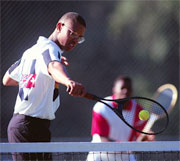Analyzing Interactions
For each interaction, you will need to:
Note that you do not need to describe gravitational interactions in terms of energy unless you completed Unit 3 Chapter 2 Activity 10 (Potential Energy). Use the following How To's for guidance (you can find them in your text):
Partners: If you do one of these activities with a partner, you should split the work up by interactions. For example, if you and your partner need to analyze twelve interactions, then each partner should analyze six. Then you should evaluate your partner's analyses and explanations, and he should evaluate yours. Everyday InteractionsAnalyze and explain a specific number of interactions of your choice from your own world. For example, describe interactions that take place in your home every day. What interactions take place when someone is cooking a meal at home? Or when someone watches TV, or plays a video game? What interactions occur when you listen to the stereo? Or when you take a shower or a bath? Or consider sports. What interactions occur when you play soccer? Football? Tennis? Water polo? Basketball? What about when you walk, run, or swim? See the Everyday Interactions activity sheet (pdf). Visualizing Interactions
Make sure that in your report, you follow guidelines for citing the magazines and newspapers from which you get your pictures.
Interactions in HollywoodAnalyze a short clip from a movie or a TV show in terms of interactions, energy and/or forces. A good example is the scene in Breaking Away (1979) in which Dave (the bicyclist) rides behind a truck in order to reach high speeds (50-60 mph). A similar action sequence from a movie or television show would work just as well. See the InterActions in Hollywood activity sheet (pdf). Action scenes are fine, but avoid choosing violent sequences (e.g., gunfights). Partners: This is good project for a team of two. A team of two could either analyze a longer clip of the TV show or movie, or a short clip that is particularly full of interactions (for example, a heavy action scene). In either case, you should expect that a team of two would analyze twice as many interactions as a single student. Impossible Interactions?Take a picture, video clip or passage from a fantasy or science fiction film, show, book, or comic in which something fantastic takes place, and identify what forces would need to be present in order for that event to occur in reality. See the Impossible Interactions? activity sheet (pdf). Here's an example. In The Empire Strikes Back (1980), Luke Skywalker uses "The Force" to suspend R2-D2 in mid-air. What is direction and size of the force used to hold R2-D2 in the air like that? For this example, consider that R2-D2 is on a planet (Dagobah). Therefore, a gravitational force should be pulling him toward the ground. If he is not moving, then the total force on him is zero. Therefore, there would need to be a force acting on R2-D2 that balances the gravitational force. This force would have the same strength as the gravitational force, but it points in the opposite direction (upward). This is the completely fictional force that Luke is exerting on R2-D2. For this project, try to include copies of the picture, video clip or passage, and include a full citation. For a picture, describe what the picture depicts. For a book, describe the scene you are analyzing. For a comic book, include a copy of the most relevant frame and describe the scene. For a video clip, try to include a snapshot (unless you can in the full clip) and describe the action in detail. In every case, you also need:
|
|
 The purpose of these activities is to apply InterActions ideas to new situations. These activities require you to find and analyze interactions in the real world outside of your classroom, or in fictional worlds like those shown in movies.
The number of interactions you'll need to analyze is up to your teacher, but as
a guide, you should expect to analyze around six (per student).
The purpose of these activities is to apply InterActions ideas to new situations. These activities require you to find and analyze interactions in the real world outside of your classroom, or in fictional worlds like those shown in movies.
The number of interactions you'll need to analyze is up to your teacher, but as
a guide, you should expect to analyze around six (per student). Cut pictures from magazines or newspapers and analyze them in terms of interactions,
energy and/or forces. Pictures showing sporting events or athletic activities
are particularly good for this purpose, though not exclusively so. Consider
also popular electronics, mechanics or science magazines. See the
Cut pictures from magazines or newspapers and analyze them in terms of interactions,
energy and/or forces. Pictures showing sporting events or athletic activities
are particularly good for this purpose, though not exclusively so. Consider
also popular electronics, mechanics or science magazines. See the